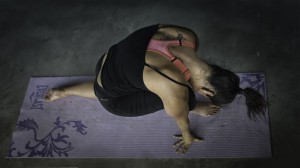- Calls to this hotline are currently being directed to Within Health or Eating Disorder Solutions
- Representatives are standing by 24/7 to help answer your questions
- All calls are confidential and HIPAA compliant
- There is no obligation or cost to call
- Eating Disorder Hope does not receive any commissions or fees dependent upon which provider you select
- Additional treatment providers are located on our directory or samhsa.gov
Understanding Different Forms of Yoga and Which to Incorporate in My Treatment

The practice of yoga, which is based in ancient Eastern teachings, has grown in popularity over the past few decades within Westernized societies.
Yoga incorporates the movement of physical postures, or asanas, with the breath of mindfulness and meditation. Yoga offers new methods of treatment to those struggling with an eating disorder as a mind–body therapy that can promote a stronger connection with, and a greater acceptance of, oneself and one’s body [1].
Yoga is often used as an experiential therapy in eating disorder treatment programs. In 2006, a study was done on 18 residential eating disorder treatment programs and results showed that two-thirds of the programs offered yoga [1].
The practice focuses on deep breathing, mindfulness, and attention to how the body is working. Yoga can allow a person to move their attention from their worries to the mind and body in the moment. It allows a person to redirect all their pain and energy into the mat.
Peaceful meditation allows for re-centering of thought processes, and poses provide strength of the body and redirection in the flow of the body’s energy [5].
Yoga can be used as an effective tool to restore the mind and body. It can balance emotions and improve depressive symptoms, reduce anger and anxiety, and promote equanimity, which is a calm, clear, and focused mind [8].
With practice, yoga can improve self-esteem, promote a positive body image, and build strength. As a person practices the art of yoga, a sense of being non-judgmental with self, being open, and acceptance of self begins to occur.
What are the Different Types of Yoga?
Yoga in Sanskrit is “union.” It can be centering, balancing, and quietly relax states of the mind and body [4].
There are various options for types of yoga that a person can participate in. These include disciplines that study
- Yoga scriptures,
- Devotional practices,
- Meditation,
- Concentration,
- Breathing,
- And physical development.
Hatha is a type of yoga offered a most every yoga studio or gym. Hatha was originally developed as physical training for people to sit in meditation. Typically, any movement that involves physical postures is considered hatha yoga. Hatha is the most common yoga participated in and most widely known in Westernized societies.
Yin yoga is a separate form of yoga where the individual holds postures for longer periods of time. Most of the practice time is spent on the floor and Yin is considered to be the grounding side of the yin/yang concept [6]. Being able to hold postures for a longer period of time helps build tolerance and allowance for self to be in the discomfort and be aware of self.
This type of yoga can be beneficial for the person who struggles with food addiction or binge eating. At the beginning of practice, it may feel intolerable, but during practice the person learns how to endure the pose and embrace the uneasiness until it passes.

Other forms of yoga, such as Lyengar, Integral Yoga, Vini Yoga, and Anusara, are slower in pace for the student, and the focus is primarily on breath, body alignment, and noticing body sensations and emotions. These can improve awareness, relaxation, impulse control and body image [3].
Bikram or hot yoga is a strenuous type of yoga which is counter-productive for those who are weight restoring. There is emphasis on breathing and alignment, but further focus on form of the poses. The studio room is typically 90 degrees or higher, and strenuous practice during the class tends to create a feeling of relaxation [4].
The Benefits to Yoga Practice
There are many benefits to practicing yoga, especially for those struggling with an eating disorder. It can be very powerful when done in conjunction with treatment.
Hatha yoga teaches stillness and awareness of mind and body. It provides a space to practice relaxation and mindfulness with instruction on breathing and body posture [4]. Regular practice of hatha yoga can help identify tense muscles, relaxation techniques, and proper breathing to reverse the physiology of stress.
Yoga can also offer mindfulness and awareness of body. A yoga instructor will give prompts through the class to notice what the body is feeling and one’s breathing.
Research by the University of Hartford looked at the benefits and healing properties of yoga for eating disorders [5]. Women were followed for six weeks while participating in a yoga workshop.
All participants had a history of an eating disorder. Results showed that the women who attended the workshop were better at identifying their emotional states, being aware of their emotional states, and found themselves more capable of handling their mood fluctuations. There was also a significant drop in their level of eating concerns.
Yin yoga works to strengthen the connective tissues, bones, and fascia, versus other forms of yoga that work on stretching and strengthening muscles [6]. It can help with changing the actual architecture of the body, thoughts, and emotions.
How Yoga is a Helpful Part of Treatment for Eating Disorders
Yoga can offer opportunities to assess and heal negative body image. Various poses challenge the individual to use balance, strength, stamina, stillness, mindfulness, and flexibility.
Individuals will have the opportunity to practice tuning into habitual thoughts, feelings and self-critical thoughts during their practice. Yoga practice can increase self-empathy and de-emphasize appearance through not having mirrors in studios.
Practicing yoga can help with urges and impulses of eating disorder behaviors. It can encourage students when holding a pose or noticing discomfort to breathe and listen for what the mind and body is conveying. This can be extremely valuable to those who are numbing or escaping emotional pain during treatment.
Within yoga, eating disorders are viewed as a dysfunction of the first chakra in the yogic system [8]. To balance this chakra, poses are used that target the area of the base of the spine, such as staff posture or pigeon, as well as grounding postures, such as Warrior 1 and 2.
Incorporating yoga into your eating disorder treatment can have a significant impact on your emotional, mental, and physical well-being. It can help cultivate a sense of control, and reduce eating disorder symptoms.

The forms of yoga that you use will change, just as your recovery skills change as you grow and work towards an eating disorder free life.

Libby currently works as a counselor at Fontbonne University and is a Adjunct Professor at Saint Louis University, and is a contributing author for Addiction Hope and Eating Disorder Hope. Libby lives in the St. Louis area with her husband and two daughters. She enjoys spending time with her family, running, and watching movies.
References:
[1] Neumark-Sztainer, D. (2014, July). Yoga and eating disorders: is there a place for yoga in the prevention and treatment of eating disorders and disordered eating behaviours? Retrieved March, 2017, from https://www.ncbi.nlm.nih.gov/pmc/articles/PMC4047628/
[2] Hatha Yoga as Adjunct for Eating Disorders Treatment. (n.d.). Retrieved March, 2017, from http://www.gretchennewmark.com/blog/hatha-yoga-as-adjunct-for-eating-disorders-treatment/
[3] Nebel, B. S. (2016, March 29). What is Yin Yoga? Retrieved March, 2017, from http://www.betterbodyesteem.com/what-is-yin-yoga/
[4] Y., & T. (2014, April 14). Yoga Therapy for Eating Disorders. Retrieved March, 2017, from http://www.yogabasics.com/learn/yoga-therapy-for-eating-disorders/
The opinions and views of our guest contributors are shared to provide a broad perspective of eating disorders. These are not necessarily the views of Eating Disorder Hope, but an effort to offer discussion of various issues by different concerned individuals.
We at Eating Disorder Hope understand that eating disorders result from a combination of environmental and genetic factors. If you or a loved one are suffering from an eating disorder, please know that there is hope for you, and seek immediate professional help.
Published on May 5, 2017.
Reviewed By: Jacquelyn Ekern, MS, LPC on May 3, 2017.
Published on EatingDisorderHope.com
